
Quarry
Before limestone extraction began, woodland covered the hillside at Whitman’s Hill. When quarrying stopped in 1988, there was a large expanse of bare rock with a few pools and no vegetation. Over time, the quarry is being recolonised by plants and animals and progress has been monitored since 2005. In the nearly 20 years since quarrying ceased, colonisation has been slow. The site safety works which took place in 2006 were extensive and removed much of the ground flora. It will be interesting to monitor the recolonization process in the years to come, particularly on the embankments of loose debris.
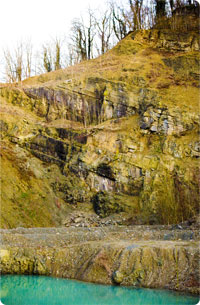 As the rock is Silurian limestone, the
plants are mainly lime-loving calcicoles,
but frequently, the lime in the surface
gets dissolved by rain water producing
more acidic conditions. This is shown
by the presence of such plants as Wood
Sage and Tormentil, whereas Marjoram,
Ploughman’s-spikenard and Yellow-wort
are good lime indicators. Between the
limestone rocks are thin layers of volcanic
ash, deposited by ancient volcanoes.
These softer layers are easier for plants to
recolonise as they are more nutrient-rich
and hold water more efficiently.
As the rock is Silurian limestone, the
plants are mainly lime-loving calcicoles,
but frequently, the lime in the surface
gets dissolved by rain water producing
more acidic conditions. This is shown
by the presence of such plants as Wood
Sage and Tormentil, whereas Marjoram,
Ploughman’s-spikenard and Yellow-wort
are good lime indicators. Between the
limestone rocks are thin layers of volcanic
ash, deposited by ancient volcanoes.
These softer layers are easier for plants to
recolonise as they are more nutrient-rich
and hold water more efficiently.
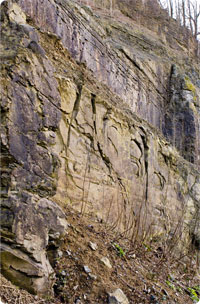
The largest and most obvious plants to colonise the area so far are the Buddleja shrubs with their purple flowers and the Silver Birch trees with their distinctive bark. The perennial, Traveller’s Joy, is steadily covering the slopes with its green carpet in Spring and its fluffy seed heads in Autumn.
Plants growing on the quarry floor have
to cope with many difficulties. The soil is
thin, giving little room for root spread or
for earthworms and other invertebrates
which help with soil aeration. The plants
lack shade which, coupled with poor
water absorption and good drainage, mean
that they have to cope with very arid
conditions, especially in hot summers.
Consequently, many of the plants are
annuals which rely on rapid flowering and
seed dispersal for their survival.
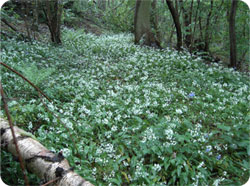 Some of
these have thick leaves to cope with the
dry conditions or seed prolifically. Over
40 species were recorded in 2005/6 but
the most common ones were Marjoram,
Perforate St. John’s-wort, Wood Sage,
Wild Basil and Teasel. Also present were
Ploughman’s-spikenard, Yellow-wort,
Centaury, Tormentil and Blue Fleabane,
whilst the Wild Strawberries seem quite
at home on the higher slopes where their
many tiny red fruits can be seen in June.
Most of the plants so far are puny
specimens, struggling to attain height in
difficult conditions. The plants trying to
grow on the slopes have to contend with
the same difficulties plus rainwater run-off
removing the thin soil. Only after many
years, with the gradual build up of soil and
more invertebrate action, will conditions
improve allowing further growth and plant
succession.
Some of
these have thick leaves to cope with the
dry conditions or seed prolifically. Over
40 species were recorded in 2005/6 but
the most common ones were Marjoram,
Perforate St. John’s-wort, Wood Sage,
Wild Basil and Teasel. Also present were
Ploughman’s-spikenard, Yellow-wort,
Centaury, Tormentil and Blue Fleabane,
whilst the Wild Strawberries seem quite
at home on the higher slopes where their
many tiny red fruits can be seen in June.
Most of the plants so far are puny
specimens, struggling to attain height in
difficult conditions. The plants trying to
grow on the slopes have to contend with
the same difficulties plus rainwater run-off
removing the thin soil. Only after many
years, with the gradual build up of soil and
more invertebrate action, will conditions
improve allowing further growth and plant
succession.
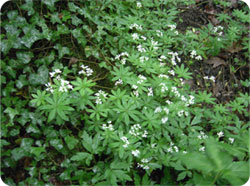 A few butterflies have been attracted to
the vegetation, especially the Buddleja
bushes. Small Tortoiseshell, Painted Lady,
Large White and Red Admiral have been
observed.
A few butterflies have been attracted to
the vegetation, especially the Buddleja
bushes. Small Tortoiseshell, Painted Lady,
Large White and Red Admiral have been
observed.
The ponds are fairly shallow and alkaline, having a bottom of limy mud with negligible plant growth, apart from some Curled Pondweed in the western pond and Stonewort in several others. As the name implies, Stonewort feels gritty as it is encrusted in calcium carbonate. In view of the limited pond plant life, it would seem that the food chains must be based on bacterial decay of leaf litter blown in from the surrounding woods. As a result of this lack of food there is little aquatic animal life so far, apart from some Water boatmen, Caddis-fly, Mayfly larva and one Palmate Newt seen passing through. The reflective surface of the water attracts flying insects such as water beetles and dragonflies. However their visits are short-lived with few plants to sustain the basis for a food chain or for egg-laying platforms. As the years go by, it will be interesting to see how the vegetation in the quarry changes and increases, encouraging a build-up of soil and being capable of sustaining further insect and animal life.
Woodland

The area surrounding the quarry is
predominantly Ash-Oak woodland
with Hazel understorey.
There are also
some Sycamore, Yew and both species of
Chestnut.
Unlike the quarry, it has not
been disturbed for a very long time. It is
well established
woodland with the
trees providing
 holes and niches in
which invertebrates
and birds can breed
and over-winter.
Some of the trees
have been coppiced
in the past for
usable wood and
there are several grown out coppice stools
that are an interesting shape, beside the
path. The presence of Yew, Spindle and
Wild Service trees indicate it has ancient
woodland origins. The first flowers to
appear early in the year, before being
shaded out by the leaf canopy, are those
of Dog’s Mercury which produces its
small, green, male and female flowers on
separate plants. Later in the spring, the
woodland floor is carpeted with Bluebells,
Wood Anemone and Wild Garlic and has
a patch of the rarer Herb
Paris. Clumps of Primroses,
Yellow Archangel, Bugle and
Violets grow along the edges
of the paths. Later, the
wild Roses and Honeysuckle
scramble through the trees
to find the light. A range of
fungi grow on the decaying
trees and leaf litter
throughout the year. The
adjacent woodland on the
ridge to the east towards
Malvern is very rich in plants
and has SSSI status.
holes and niches in
which invertebrates
and birds can breed
and over-winter.
Some of the trees
have been coppiced
in the past for
usable wood and
there are several grown out coppice stools
that are an interesting shape, beside the
path. The presence of Yew, Spindle and
Wild Service trees indicate it has ancient
woodland origins. The first flowers to
appear early in the year, before being
shaded out by the leaf canopy, are those
of Dog’s Mercury which produces its
small, green, male and female flowers on
separate plants. Later in the spring, the
woodland floor is carpeted with Bluebells,
Wood Anemone and Wild Garlic and has
a patch of the rarer Herb
Paris. Clumps of Primroses,
Yellow Archangel, Bugle and
Violets grow along the edges
of the paths. Later, the
wild Roses and Honeysuckle
scramble through the trees
to find the light. A range of
fungi grow on the decaying
trees and leaf litter
throughout the year. The
adjacent woodland on the
ridge to the east towards
Malvern is very rich in plants
and has SSSI status.
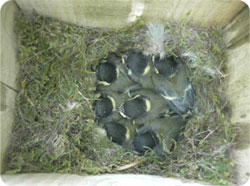
So far 25 species of birds have been noted in the area. Nest boxes have been erected in the wood and have been well used, mainly by Blue Tits, and Great Tits, also a Nuthatch successfully raised its whole brood. A Tree Creeper’s nest was found but later predated before the chicks could hatch. Coal Tit, Marsh Tit, Robin and Chiffchaff are regularly seen as well as the Long-tailed Tit, Wren and Blackcap. The Great Spotted Woodpecker can be heard drumming to attract a mate in spring and pecking to make a nest hole or find insects in decaying trees. There are often several Buzzards to be heard and seen circling overhead.
The site is potentially suitable for Dormice and they have been reported in neighbouring woodland. Boxes have been set up and are being monitored; there is already evidence of Dormouse occupation.
Hopefully the woodland of Whitman’s Hill will remain undisturbed far into the future and continue to be a haven for wildlife.

